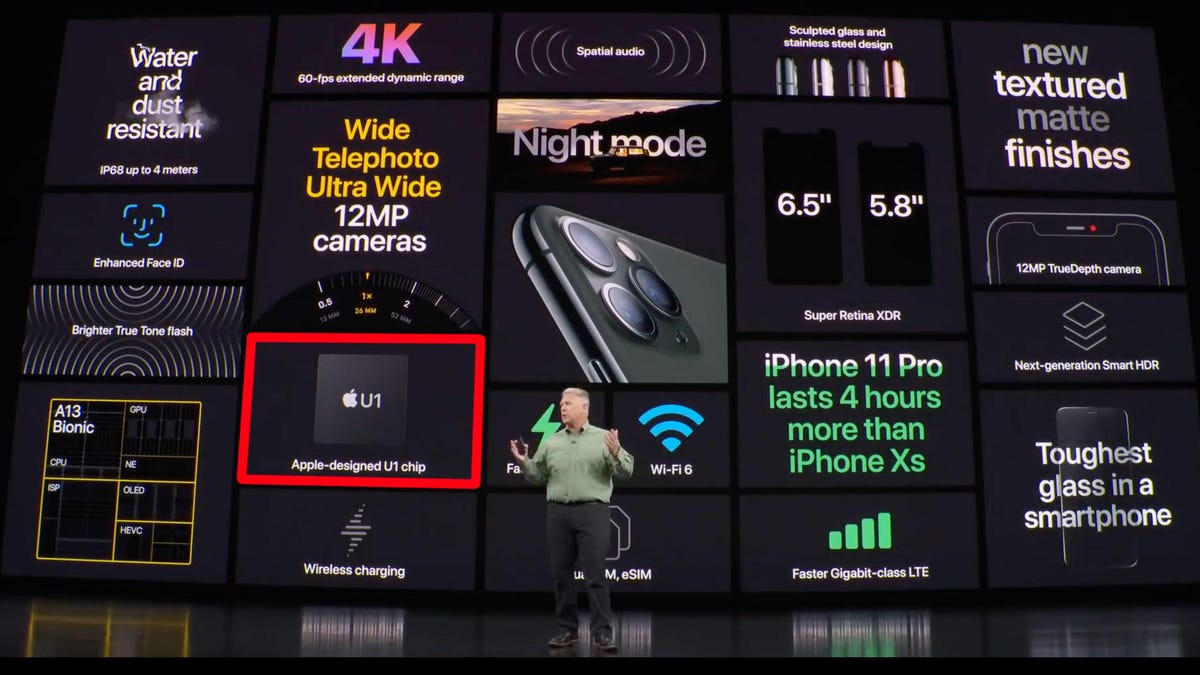No, Verizon's 5G Ultra Wideband and Apple's U1 ultra wideband chip are not related
One's a branding effort, and one's a new type of tech.

Apple marketing chief Phil Schiller touted the company's U1 chip for UWB in the iPhone 11.
You may have heard the term "ultra wideband" getting thrown around by both Apple and Verizon , but their two use cases are actually very different. Here's what you need to know about UWB.
Apple's ultra wideband U1 chip
Apple's U1 chip is the company's first use of sophisticated location-tracking technology that's faster, more precise and more secure than GPS-based location tracking. It can better pinpoint the exact location of phones , key fobs and tracking tags. It's been used in other fields for a while now.
One use case is in the NFL: Football players have UWB transmitters in their shoulder pads to precisely locate a football for instant replay animations. The U1 chip's UWB technology works a bit like radar, using small transmitters to send out lots of little pulses across a wide array of radio waves in varying intensity, then measuring how long it takes the pulses to travel.
By building UWB into the iPhone 11, Apple is looking to incorporate this location technology to get faster user-to-user sharing, new smart home product features, and possibly its rumored smart tracking tags.
"With U1 and iOS 13, you can point your iPhone toward someone else's, and AirDrop will prioritize that device so you can share files faster. And that's just the beginning," Apple says.
Since UWB works faster than Bluetooth and includes cryptographic protections to make it more secure, other conceivable uses of a UWB chip could be unlocking your car door simply by approaching it while carrying your phone, locating a lost pet wearing a UWB tag, or shifting your smart home's lighting and sound just by walking through it.
Read more: Apple built UWB into the iPhone 11. Here's what you need to know (FAQ)
Verizon's 5G Ultra Wideband
In rolling out its promised 5G network, Verizon is laying a confusing claim to the words "5G Ultra Wideband."
"5G Ultra Wideband is our brand name for our 5G service," said Verizon spokesman Kevin King. "It's not a technology."
5G is the next (fifth) generation of cellular technology, which promises to greatly enhance the speed, coverage and responsiveness of wireless networks. Verizon's 5G network speeds were found in tests to be 10 to 100 times faster than a typical cellular connection, at more than 1 gigabit per second. That's also faster than physical fiber-optic cable internet.
5G works by sending signals through an extremely high frequency in the electromagnetic spectrum, called millimeter wave (aka mmWave). It's within the radio wave range, where most all of our broadcasting and mobile devices' information travels. The longer the wavelength, the lower the frequency, and the lower the bandwidth.
You can climb right up the electromagnetic radio wave range until you get into 5G territory where wavelengths are very short -- about 1 to 10 millimeters -- and the bandwidth is very large. The tradeoff is that your signal is going to travel shorter distances and be more finicky, which is why you need a lot of little transmitter towers, which are considered a type of "small cells" (most are only a couple of feet tall, and closer to the 5G device in your hands).
Mobile carriers have to contract with the government in order to get access rights to a part of the radio spectrum, in the US and other countries. And as mobile carriers race to deploy 5G networks, each is looking to stand out from their competitors.
In Verizon's case, that means using a mixture of internet technologies: It's bested some competitors to get a range of mmWave spectrum (some higher parts of the 5G range, some lower), then combine it with an end-to-end fiber network, and a lot of small cells. Hinting at this mixture of different bandwidths, Verizon called its particular 5G deployment concoction "Ultra Wideband."
Read more: Verizon says its 'Ultra Wideband 5G' will be better than the rest

